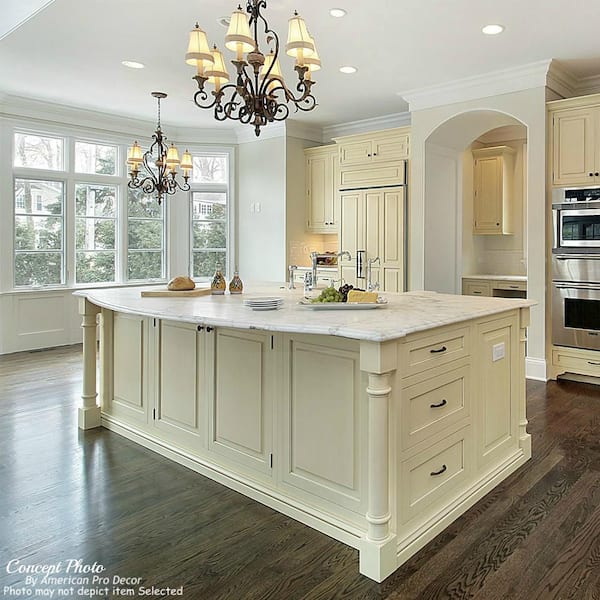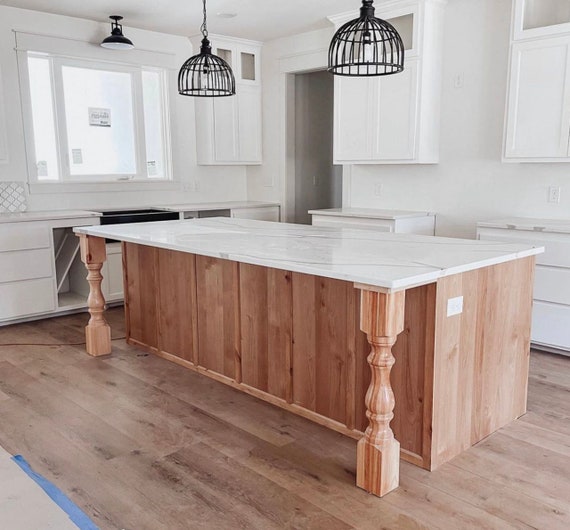Attain the Perfect Equilibrium of Kind and Feature with Legs For Kitchen Island
Attain the Perfect Equilibrium of Kind and Feature with Legs For Kitchen Island
Blog Article
Essential Variables to Consider When Selecting Legs For Cooking Area Island
Selecting the proper legs for a kitchen area island involves a mindful assessment of several aspects that can substantially influence both capability and visual appeal. Amongst these, the choice of material plays an essential role in ensuring toughness, while the design needs to complement the existing decoration. Additionally, considerations such as height and weight support are important for stability and comfort. As we discover these elements, it becomes clear that each choice can have far-reaching implications for the overall cooking area experience. What nuances should be taken into consideration in each of these classifications to accomplish the ideal balance?
Material Options
When choosing legs for a cooking area island, recognizing the various product options is vital for achieving both visual allure and structural honesty (Legs For Kitchen Island). The choice of material considerably influences not just the durability of the island but also its total layout and functionality
Wood is a popular selection, offering heat and adaptability. Strong hardwoods, such as oak or maple, provide strength and can be stained or repainted to match the kitchen decor. Metal legs, often made from stainless steel or functioned iron, contribute a industrial and modern feeling while guaranteeing toughness and stability. These materials are immune to use and can support significant weight, making them perfect for bigger islands.
One more alternative is crafted products, like MDF or plywood, which can be much more cost-efficient while still providing a series of coatings. However, they may not offer the same degree of security as strong wood or steel. Last but not least, materials such as acrylic or glass can produce a modern look, though they might call for additional support to guarantee security.
Eventually, the choice of product for cooking area island legs need to align with the wanted functionality and the general theme of the kitchen area.
Design and Design

When thinking about style, the shape and finish of the legs are crucial. Conical legs can give a sense of lightness and style, while thicker, extra robust legs can communicate stamina and security. Furthermore, the surface-- be it repainted, tarnished, or all-natural-- must enhance the cabinetry and kitchen counter products to produce a unified appearance.
Moreover, the style of the legs can also show personal preference. Custom-made or ornamental legs, such as those featuring elaborate makings or special geometric forms, can work as centerpieces, adding character and personality to the kitchen area. Ultimately, the ideal option will certainly not just improve capability however also raise the aesthetic allure, making the kitchen area island a standout feature of the home.
Height Considerations
Choosing the suitable elevation for go to this website kitchen area island legs is crucial, as it directly affects both capability and comfort. The typical elevation for a kitchen island typically varies from 36 to 42 inches, straightening with usual counter top heights. A 36-inch height is ideal for cooking and cooking, allowing for comfortable use of kitchen home appliances and devices. On the other hand, an elevation of 42 inches is frequently preferred for islands planned for bar seating, suiting taller feceses and supplying a laid-back dining experience.

It is additionally vital to represent users' choices and elevations. Personalizing the height can make certain a comfortable experience for all family participants, making the kitchen island an extra practical and delightful room.
Weight Support
Ensuring appropriate weight support for kitchen area island legs is vital for both safety and security and functionality. The cooking area island frequently offers multiple purposes, consisting of food preparation, eating, and extra storage, demanding a durable assistance framework. When picking legs, it is essential to take into consideration the total weight capability required based on the island's intended usage and the materials that will be positioned on it.
The selection of material for the legs plays a considerable role in their weight-bearing capacities. Solid wood, steel, and sturdy composites normally give exceptional stamina contrasted to lighter materials. Furthermore, the layout of the legs-- whether they are straight, tapered, or have a pedestal type-- can affect their capacity to disperse weight effectively across the framework.
Always speak with the supplier's requirements concerning lots limitations to guarantee that the legs can sustain the intended weight without compromising safety and security. In recap, picking cooking area island legs with appropriate weight support is vital for producing a useful and secure culinary space.
Installation and Upkeep
Correct setup and maintenance of kitchen island legs are essential for making certain durability and stability. To start, it is vital to comply with the producer's standards throughout installation. This often entails protecting the legs to the island base making use of suitable bolts, making sure that the legs are level and straightened. Using a degree tool can help stop wobbling and boost the overall visual charm of the cooking area island.
Once set up, normal maintenance is needed to preserve the stability and look of the legs - Legs For Kitchen Island. For wood legs, periodic cleansing with internet a wet fabric and application of ideal timber polish can stop dampness damage and preserve their coating. Metal legs may need a mild cleaning service see this to get rid of oil and grime, complied with by a completely dry towel to avoid corrosion development
Furthermore, check the legs routinely for signs of wear or damage, such as fractures or loose joints. Tightening screws or bolts as needed can also extend the life expectancy of the legs. By sticking to these setup and upkeep methods, house owners can make sure that their cooking area island continues to be strong and aesthetically appealing for many years to find.
Final Thought

Aesthetic coherence is critical in choosing the design and layout of legs for a cooking area island, as these elements substantially affect the total ambiance of the space. Tapered legs can offer a sense of lightness and beauty, while thicker, a lot more durable legs can communicate stamina and security.Selecting the proper elevation for cooking area island legs is essential, as it straight impacts both capability and convenience. In recap, selecting cooking area island legs with adequate weight assistance is vital for creating a functional and safe culinary area.
In verdict, choosing legs for a kitchen area island necessitates careful factor to consider of numerous variables, consisting of product choices, design, height, weight assistance, and setup.
Report this page